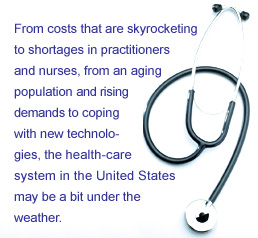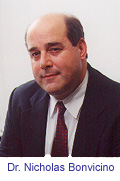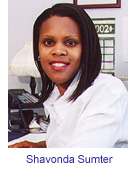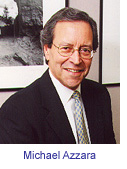

|
. |


Numbers don’t tell the whole story, but they reveal something short of a clean bill of health. Time magazine reports that, nationally, insurance premiums rose 11 percent last year and warns us to look out for a 15 percent jump this year. In New Jersey, according to The Star Ledger, health-care benefit costs rose at three times the rate of overall inflation: a whopping 8 percent last year — on top of 8.9 percent in 2000. The same study shows that more than half of employers surveyed expect health-care inflation to reach double digits this year. Many employers have had to increase employees’ share of premiums, raise co-payments and deductibles and even reduce coverage to be able to afford to insure their workers. Add to that the growing pool of senior citizens and the shrinking resources of the Medicare and Medicaid programs — not to mention the millions without any coverage — and signs of trouble are unmistakable. Fairleigh Dickinson University is working closely with the current and future leaders in health care who will ride out the storm. Particularly, in the executive MBA in health systems management program and the Henry P. Becton School of Nursing and Allied Health, the University is making vital contributions. FDU Magazine spoke to faculty and alumni of these programs to gain better insight on the health-care challenges and the forecast for the future. Drug Costs TargetedMany people blame rising health-care costs on pharmaceutical expenditures. The Record reported recently that, according to NDCHealth, an Atlanta, Ga.-based provider of market data for health-care companies, overall drug sales jumped 17.9 percent to $208 billion last year. “This is the most rapidly increasing health-care cost,” says Michael Azzara, senior executive fellow for the health systems management MBA program and president, Valley Health System, Paramus, N.J., a $350-million-per-year organization that includes The Valley Hospital in Ridgewood, Valley Home and Community Healthcare and seven urgent care/primary care centers throughout Bergen and Passaic Counties. NDCHealth reports that in 2001, 3.3 billion prescriptions were dispensed. Direct-to-consumer advertising spending, which, according to the Associated Press, tripled to nearly $2.5 billion a year between 1996 and 2000, is fueling this demand. “Consumer-directed advertising has, without a doubt, increased spending on drugs,” Azzara agrees. He says that increased pressure from patients requesting specific medications has doctors writing prescriptions, even when that may not be the best course of treatment. High patient loads, with little time scheduled for each, add to the problem. “These physicians aren’t being paid to spend a half-hour with the patient,” he laments. |

|
One of the highest sectors of drug-cost increase, according to Dr. Nicholas Bonvicino, MBA’00 (T-H), senior regional medical director for Newark-based Horizon Blue Cross Blue Shield of New Jersey, is “lifestyle” drugs. These are drugs that, although they do bring comfort or relief to people with chronic, non-life-threatening conditions, are not medically necessary to maintain life or limb. These include, for example drugs for hair loss and sexual dysfunction. They are widely advertised, can be extremely expensive and bring people into the doctor’s office who may not otherwise have sought medical advice, leading to increased medical expenses all around. Semi-managed CareInefficiency in the current medical system also increases health-care costs. This was supposedly addressed by the growth of managed care, using health maintenance organizations (HMOs) to streamline the entire health-care process and eliminate redundancies. Recently, however, 50 percent of people in a Harris poll reported they don’t like managed care, and enrollment in these plans is falling. Traditional managed care models have been pushed aside by options that favor freedom of choice. Says Bonvicino, “The marketplace is swinging away from [managed care].” Patients want to see their own doctors; physicians and hospitals want better contracts (i.e., higher pay, less hassle) from insurers; and even those on Medicare, who are offered enhanced benefits such as prescription drug coverage if they choose managed care, are turning away from it. In addition, senior citizens are often perplexed by managed care. They have difficulty “reading the program booklets and do not understand them well enough to get the full benefit,” says Bonvicino. Not Just Dollars RisingAs “baby boomers” reach their 60s, the Medicare system is in danger of becoming short-funded. “The Medicare population comprises the highest users of health care and also the most costly,” says Bonvicino; however, he believes that Medicare offers the greatest opportunity for health-care cost savings. “Here we can do comprehensive assessments, be proactive and predict problems and manage them at early stages for less cost,” he says. 
Beyond basic medical needs, comprehensive services are needed for seniors, says Shavonda Sumter, MBA’01 (T-H), vice president, government affairs and public relations for 2nd Home, a Paterson, N.J.-based group of five adult medical day care facilities geared toward the Medicaid population. She points out that medical day care, a field with a growth rate of 18 percent, and social needs “go hand-in-hand.” 2nd Home’s five-hour daily program provides two meals a day, therapeutic activities, supervision with medication, transportation to and from medical appointments and social services. The increasing numbers of senior citizens is putting a strain on the Medicaid system as well. “By 2030, it is estimated that Medicaid funds will be depleted,” Sumter points out. Because it is funded by both the federal government and the state, Medicaid is particularly susceptible to budget shortfalls. Seniors need help navigating the maze of government benefits to which they are entitled, and they need advocacy in the political arena. “Not all cost increases and expenditures are bad,” Azzara counters. With longer life spans and more treatment options available, “people are spending more over their lifetimes on health care.” Bonvicino adds, “If people can be kept healthy enough to continue as contributing members of society, it’s a necessary — even welcome — cost.” In Short SupplyProblems in the health-care system are aggravated by limited human resources. Personnel shortages exist in practically every area of health care, from technicians to pharmacists to physicians. A federal study reported in The Record found, for example, that “more than 90 percent of nursing homes have staffing levels below the level minimally necessary to provide needed care.” The biggest staffing shortages are in critical-care nursing, says Azzara. “This area requires extensive training of nurses and is subject to early burn-out of staff,” due to the physical and mental demands on the critical-care nurse. With the population aging, “there are more older people with more complex situations such as heart disease, Alzheimer’s, diabetes or a combination of conditions,” says Minerva Guttman, director of the Henry P. Becton School of Nursing and Allied Health. “And, there are many with infectious diseases such as AIDS or tuberculosis. People are sicker when they enter the health-care system.” 
According to Guttman, the nursing shortage is expected to last through the year 2030. Sumter adds that there also is a crucial need for bilingual nurses to meet the needs of facilities that serve large numbers of patients who do not speak English. The health-care system also is losing nurses because of long hours, mandatory overtime demands and poor working conditions. “We’re educating these people with the idealistic notion that their responsibility is patient care and to be caring professionals,” says Guttman, “yet when they enter the working world, the environment is such that they aren’t even given the time to do what is necessary to be a quality caregiver.” In addition, more than two-thirds of nurses are over the age of 40, says Guttman, and less than 10 percent are under 30. Azzara adds that, “Thirty years ago teaching, nursing and secretarial work probably represented 90 percent of the opportunities for women. This whole group of baby boomers who went into nursing are now starting to retire.” Sumter notes that the state “has instituted a waiver program for out-of-state-licensed nurses, but it is not enough.” Guttman reports that it is not uncommon to go overseas to recruit qualified nurses. However, “the nursing shortage is global,” she says. “We cannot continue going to other countries for nurses because they have their own shortages.” Prevention = $avingsWith all these demands on our limited resources, the question is where will we ever find the money? Our own behavior is one area in which all agree that savings can be made. “Recidivism of unhealthy behavior practices is high; it’s human nature,” says Bonvicino. For example, smoking is the nation’s leading cause of death and disability and costs the economy some $70 billion a year, reports The New York Times. “Individuals need to assume more responsibility for their health,” says Azzara. “Fifty percent of health is determined by behavior.” Proper diet, exercise and care of oneself can go a long way in preventing medical expense. North Jersey is near the top in one very important category. The Centers for Disease Control and Prevention ranks the area fifth in the country in areas where people are the least likely to smoke, with only 17.2 percent reporting smoking. Technologically FitHospitals also can find cost savings by examining how care is delivered. “Technology allows us to do a lot more on an outpatient basis than before,” Azzara says, enabling patients to return home more quickly after treatment. Recognizing the benefits of this, Valley Health System has just opened a $51-million outpatient cancer and same-day-surgery center in Paramus. In addition, Azzara reports, “home care allows us to treat people who ordinarily would have been hospitalized.” Taking this to the technological peak, Valley, with a grant from the Robert Wood Johnson Foundation, is experimenting with telemedicine: Using interactive video communication and remote vital-sign monitoring, nurses are able to check on patients with congestive heart failure in their homes. 
Technological advances also may help reduce redundancies in testing and treating patients. Electronic recordkeeping with access to relevant records by pertinent medical personnel has the potential to streamline the delivery of care. Azzara says, “Accumulating all that information is a major challenge. I think you’re going to see a lot more investment in computer systems, handheld computers and linking of data bases around hospitals and with outside facilities and physicians.” Recently passed federal privacy regulations, however, make sharing of medical records electronically more difficult. “Perhaps sometime in the future patients will become the guardian of their own records, putting the responsibility on the patient, as a consumer, to make sure the information is available,” Azzara theorizes. Care must be taken when jumping on the technological bandwagon. “Technological advances where there is a need for service are extremely beneficial, in the long run,” comments Bonvicino. “To be worth the cost of development, they need to deliver significantly better results than current common practices.” A Spoonful of InformationDespite increasing the demand for pharmaceuticals, consumer-directed advertising also may be a cost saver, when used responsibly. Azzara notes that “study after study shows that there are millions of people with hypertension who are not treated with medication and would benefit from it.” Television advertising could increase awareness of undetected medical conditions and bring patients in for life-saving treatment and the prevention of costly complications. Most commercials are not targeted at these opportunities, however, and many commercials don’t even name or give the symptoms of the conditions the advertised products are used for. “Getting more information in the hands of consumers is a good thing,” Azzara points out. A nearly infinite supply of medical information is available on-line; however, consumers should be careful that the information they get is from Web sites evaluated and supported by professional groups. “I think it shifts power from providers, hospitals and doctors to consumers,” he says, encouraging them to make wise decisions for themselves. Similarly, if consumers paid a larger share of the cost of lifestyle drugs and other drugs that may or may not be medically necessary, “they would be less likely to push the doctor into writing the prescription.” Political HotbedThe future of health-care reform will be hotly contested in the U.S. political arena. With aging baby-boomers expected to be 20 percent of the total U.S. population by the 2020s, there will need to be “greater dialogue between the elder-care industry and legislatures,” says Sumter. Azzara agrees, “It will be a major fight because baby-boomers control so much of the vote.” Legislation could provide added finances, but not without complications. For example, New Jersey Gov. James McGreevey has proposed a $75-million increase in funding for Pharmaceutical Assistance for the Aged and Disabled (PAAD). This plan, however, shifts some costs to the Medicaid system — which may have political implications in areas with high concentrations of Medicaid users. Political issues span beyond financing, as seen with the passage in 45 states, including New Jersey, of Patient Bills of Rights, which set the foundation for basic benefits and patients’ rights. These range from appealing the refusal of coverage to guaranteeing that patients can receive all the information necessary to make educated decisions. PrognosisThe needs and attitudes of health-care consumers, as well as the resources available to meet those needs, are continually changing. With such fluctuation, it is difficult to point to the most effective prescription for the U.S. health-care system. Technology will enable providers to use new and exciting treatment methods; yet the health-care system will be challenged to deliver those technologies to patients of all income levels. While those close to the front lines see more rough seas ahead, they all point to the importance of education — for practitioners and consumers — in stemming the tide of potential crises. |
|
Preparing Leaders for the Business of Health Care | A Case Load of Credit for Nurses FDU Magazine Directory | Table of Contents | FDU Home Page | Alumni Home Page | Comments |
|